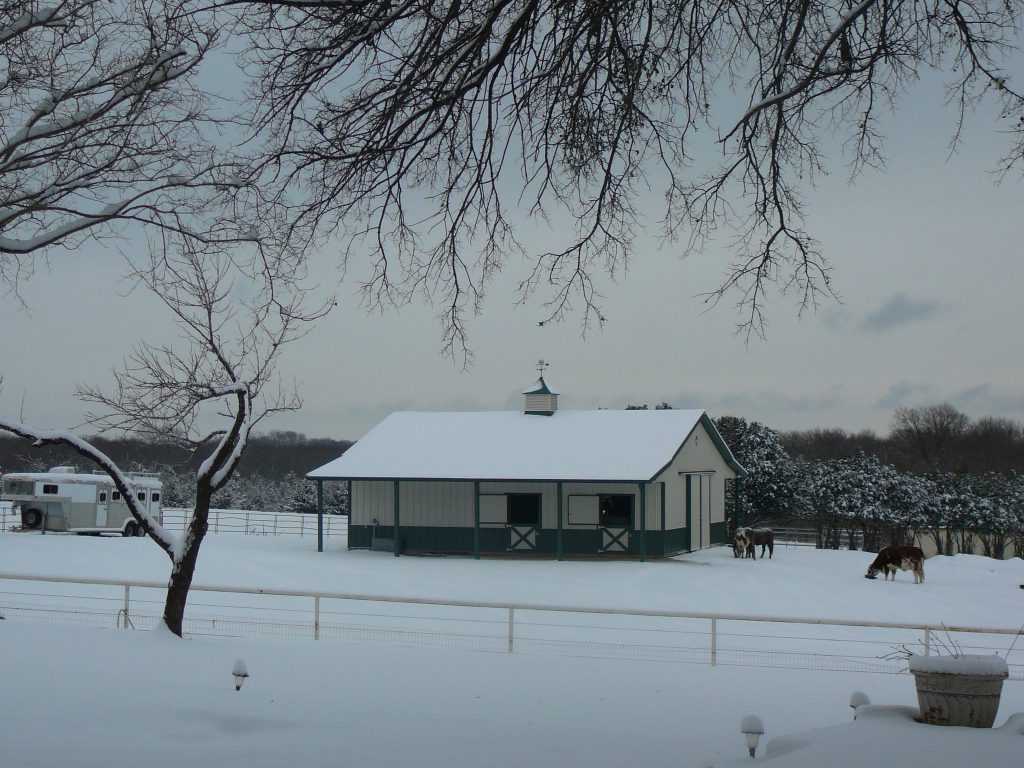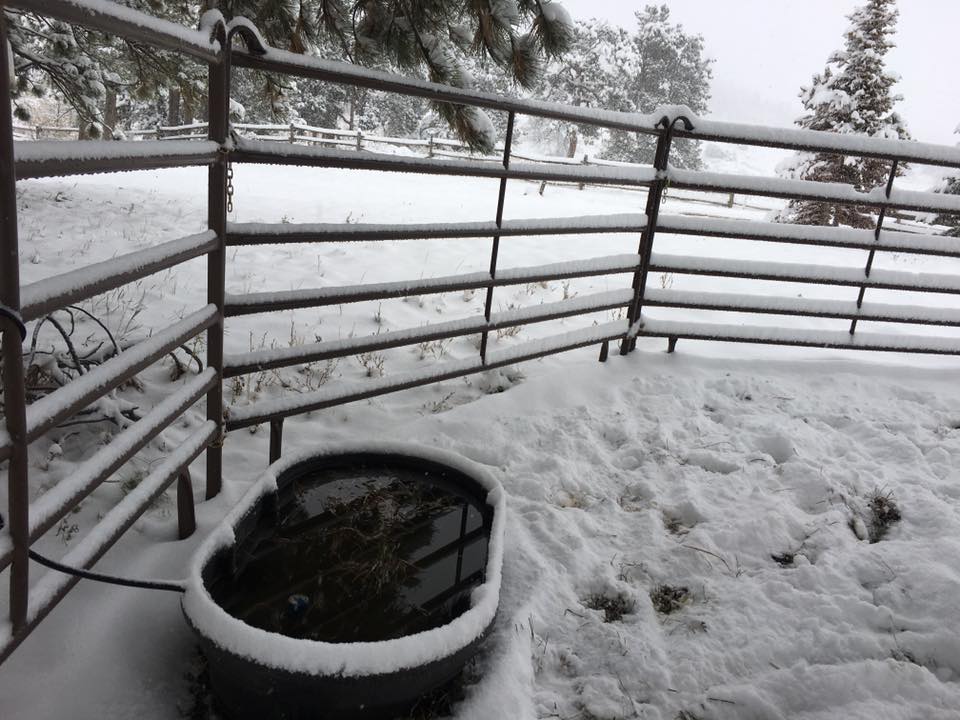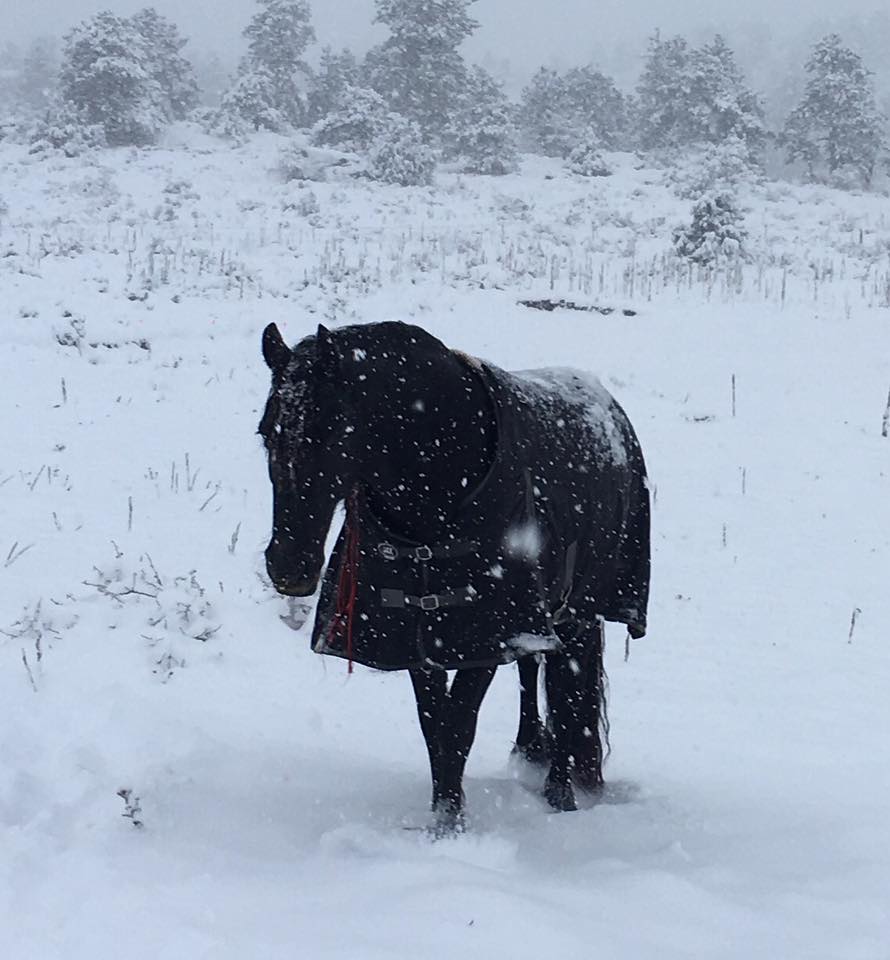By Chris Churchill, Five Star Ranch Staff Writer
One of the biggest mistakes people make in building a barn is not considering the climate. In our article on building a barn in a hot climate, we identified ways to beat the heat and get more air flow. In cold climates you want to do everything you can to make the barn warmer on those frigid winter nights. Here are a few suggestions, based on owning barns in the Rocky Mountains in Colorado.
Protection from Prevailing Cold Winds – when you plan out your stable facility, pull out a compass and identify North, South, East and West. Plan your barn so the main doors face the morning sun: East or South. If you live in an area that is prone to strong winds you may want to consider putting up a garage-style door instead of a sliding door. If you have ever tried to open a horizontal sliding door in deep snow or in 50 mile per hour winds you know how hard it is. This is when a south or east door is preferred and not a sliding door. We try to put in multiple doors so we have options depending on the weather and wind conditions.
Snow Load Considerations – Make sure your building meets or exceeds the snow load requirements in your area. If you inherit an old barn on your property, you may want to get it inspected to insure as many older constructions may not up to current standards and may not be safe. Every year there are heartbreaking pictures of collapsed barns or arenas that were not built to withstand the extremes of local conditions.
Porches over stalls with side openings from roof snow – In our area of northern Colorado, we get appreciable snow in the Spring. One of the lessons learned was from our neighbor’s barn. They built a south facing entrance to their stall, but no porch. When the accumulated snow on the roof would slide off, it would pile up on the outside of the stall. After a short while, the animals could no longer come in or out of the stall easily. A 10 foot porch would provide protection and a way for the animals to escape on the ends without having to struggle through a giant snow drift.

Insulation – this is the number one thing you can do to help keep your barn comfortable whether it’s from the heat or cold. Start with putting it in your roof. An insulated roof keeps heat out and warmth in, plus it dampens the noise of heavy rain hitting the roof so your barn will be noticeably quieter. If your budget allows insulate the walls and doors. If you can only insulate one or two walls, do the north or west walls first.
Radiant Heat in Floor – Many cold weather veterans call radiant floor heating the safest way to heat a barn. Heat lamps have started many barn fires so we don’t advocate their use unsupervised. With radiant heat in the floor, there is no fire danger and it keeps the barn tolerable (not warm) and maybe even above freezing. It is an additional expense and work putting radiant heat in but if you tied it to a system that can run on solar, you could cut the cost of using it and get years of benefits with no extra costs.
Heated Tack/Feed room – When you are working around the barn, it is nice to have a room that is heated to warm up in. My hands get numb sometimes and a two minute visit to the heated tack room gets me going again to brave the elements. I use an electric oil-filled radiator type heater in my tack room to keep the temperature in there about 65 degrees. It is safer than the glowing-wire or hot ceramic style space heaters and will turn off automatically if turned over. Separate wall, floor, and ceiling insulation for the tack and feed rooms will help protect these rooms from temperature swings and allow our small oil-filled radiator heater to keep them from freezing.
An added bonus of the heated tack is that I can fill some feed buckets with water after feeding and store them in the heated tack. When the next feeding time comes around, I can make “soup” for the horses using this room temperature water and help insure that they are getting at least some water every day.

Heated Waterers – If you ever had your water line freeze and had to haul water from the house, then you will understand the value of getting the water line deep enough to not freeze and then insulate any exposed pipes. If you can afford it, spring for an automatic heated waterer. You can get consumption gauges for them so you can monitor the amount of water consumed.
Automatic heated waterers may sound like an extravagant luxury, but the reduction in your workload and the peace of mind you will have that your horse will always have access to warm water makes it worth the extra cost. If you can’t get those installed, be sure to get a frost free pipe on your water spigot and run electric heat tape on your water spigot so it doesn’t freeze. Horses drink more in the winter when their water is not freezing cold. A well hydrated horse is less likely to colic, so having warm water available to the horses in the winter is smart horse care.
Other things you can do to help keep your outdoor water trough from freezing without electricity is to wrap the tank in insulation and place a soccer ball or basketball in the tank. Assuming the horses don’t pull it out to play with, the ball will provide a way to discourage ice growth on the surface and the horses can even push down on the ball to access water underneath.
If you have electricity near the stock tank, get an inexpensive tank heater to keep the water from freezing. We prefer the sinking kind, as our horses and donkeys have been known to pull the floating style out of the tank. 2″ PVC pipe can protect the extension cords (if used) from them as well. Some bottom heaters which install through the tank’s bottom bung, and these prevent the horses from pulling them out. That being said, we prefer the drop-in sinking style because dumping and cleaning the tanks are easier with the heater removed.
Plan to have suitable electrical outlets installed so that the wire lengths are minimized. Plan on one 15-20 amp circuit for EACH water heater – doubling up heaters on a single circuit will trip the breaker.
Deep Layered Stall Bedding – Our stalls have rubber mats covered with shavings. During cold spells we add extra shavings so our horses can snuggle down in their stalls. We also put fine shavings or wood pellets down in pee areas to control the amount of urine that is spread in the stall. The fine shavings covered with larger shavings is a great way to make a comfortable bed and contain the urine.

Blankets – My guidance for blankets is if your horses are shivering they probably need blankets. My older horses always get blankets. They have a difficult enough time maintaining their weight in the winter, no sense in having them lose weight by shivering all night.
I also blanket when it is going to be wet, even when above freezing. When horses get wet, they seem to lose their natural insulation. I have found more of my horses shivering after a wet cold than a dry cold. I also blanket horses if we have an early freeze before the horses have grown their winter coats or if they have been clipped.
In general, horses are well adapted for the cold. I have to keep telling myself that I am more bothered by the cold than they are. That said, since I am the one who cares for my herd, planning a barn that provides a good windbreak and stays dry makes my life easier. Having had to chip ice off the water trough and haul water to the horses because the spigot is frozen is miserable. Planning ahead makes everything run smoother and helps keep our horses healthy.
Related Barn Design Articles
Horse Barn Site Selection.